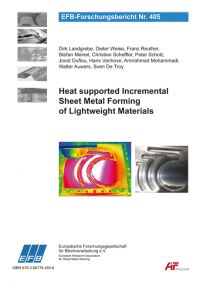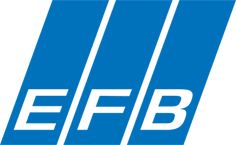Heat supported Incremental Sheet Metal Forming of Lightweight Materials

Verfasser:
Prof. Dr.-Ing. Dirk Landgrebe, Dipl.-Ing. Dieter Weise, M.Sc. Franz Reuther, Dr. Stefan Meinel, Dipl.-Ing. Christian Scheffler, Dipl.-Ing.Peter Scholz, Fraunhofer Institute for Machine Tools and Forming Technology - Prof. Dr. Ir. Joost Duflou, Hans Vanhove, Amirahmad Mohammadi, Katholieke Universiteit Leuven Research and Development - Dr. Walter Auwers, Sven De Troy, Sirris – The Collective Center of the Belgian Technological Industry
126 Seiten - 80,00 EUR (sw, 77 teils farbige Abb., 11 Tab.)
ISBN 978-3-86776-450-6
Project Summary
Incremental Sheet Forming (ISF) stands for a number of innovative, flexible forming pro-cesses in which sheet metal can be shaped into a wide variety of geometries without the need for expensive, dedicated tool sets. By means of a standard stylus, controlled by a 3- or multi-axis CNC platform, sheet material is incrementally formed until the target shape is obtained. Over the past decade substantial R&D efforts have been invested to bring these innovative processes to a mature level, gradually bringing industrial valorisation within reach. Major shortcomings in the original process capabilities, such as limited forming angles, extreme thinning and low accuracy have largely been overcome through advanced work piece analysis techniques and the introduction of intelligent tool path strategies. While there is still space for improvements in these domains, today examples of a wide variety of part geometries with accuracies in the sub-millimetre range can be demonstrated, illustrating the improved mastering of the ISF processes. This allows to conclude that the technology is gradually becoming viable for industrial valorisation.
The flexible nature of the ISF processes, especially the Single Point Incremental Forming (SPIF) variant, makes them particularly suitable for the manufacturing of small series or even unique sculptured sheet metal parts. This specifically opens perspectives for SMEs active in the fast and flexible supply of tailored parts and products. However, looking at the present state-of-the-art, a number of possible hurdles obstructing the industrial roll out of the ISF processes were identified:
1. For the basic ISF processes the range of materials that can be handled was typically limited due to formability constraints of the materials and high process forces resulting from processing high strength materials.
2. Integration of ISF with other sheet metal processes into hybrid processes offering the best of both worlds: economically adding features for customization of parts produced with other technologies or flexible production of small series. However this required appropriate solutions for process planning and flexible industrial tooling.
3. The ISF processes hold the potential to produce large, double curved parts, but the com-monly available machine tools for supporting the process do not provide such working range or come at a high investment cost. Now application labs provide access to infrastructure, knowledge and technological support to facilitate the take-up of ISF.
The ISF-Light project intensively explored the valorisation opportunities with a large number of industrial partners, most of them are SMEs, while working on the most important remaining hurdles in a concentrated effort to enlarge the valorisation window.
To overcome the identified remaining valorisation obstacles, the research efforts were concentrated on the use of two heat supported process variants (in order to allow the use of a wide range of light, high strength materials), the enlargement of working ranges compared to traditional ISF setups through the development of two large scale application lab facilities available for use by SMEs, and the integration of ISF processes in flexible sheet metal working environments in support of elimination of the geometric limitations imposed by the use of individual, stand-alone processes.
The project "Heat supported Incremental Sheet Metal Forming of Lightweight Materials." Ref.-No. AiF 71EBR was financed and supervised by the EFB. In the scope of the CORNET - European Research Programme “ISF-Light” it was funded by the German Federal Ministry for Economic Affairs and Energy via the Federation of Industrial Research Associations. The report ist published as EFB-Forschungsbericht Nr. 405.
Zusammenfassung
Temperierte inkrementelle Blechumformung an Leichtbaublechwerkstoffen
Die inkrementelle Blechumformung steht für eine Reihe von innovativen, flexiblen Umformverfahren, in denen Blech ohne kostenintensive, formspezifische Werkzeugsätze durch eine Vielzahl von aufeinander folgenden Bewegungen in die gewünschte Form gebracht wird. Mittels eines Standard-Umformdorns, welcher durch eine Drei- oder Mehrachsen-CNC-Plattform bewegt wird, entsteht sukzessive die Endform. Im vergangenen Jahrzehnt wurden erhebliche Forschungs- und Entwicklungsanstrengungen unternommen, um diese innovativen Verfahren zur Marktreife zu bringen. Nach und nach kam die industrielle Verwertung in Reichweite. Wesentliche Mängel in den ursprünglichen Prozessfähigkeiten, wie begrenzte Zargenwinkel, extreme Ausdünnungen und geringe Genauigkeiten wurden weitgehend durch fortschrittliche Werkstück-Analysetechniken und die Einführung von intelligenten Strategien zur Werkzeugbahnerzeugung überwunden. Obwohl zur Projektbeginn eine Vielzahl von Teilgeometrien mit Genauigkeiten im Submillimeterbereich herstellbar war, bestand noch immer Raum für Verbesserungen.
Die Flexibilität von inkrementellen Umformverfahren, vor allem der Variante des Ein-Punkt-Inkrementellen-Umformens, eignet sich besonders für die Herstellung von Kleinserien oder sogar Einzelteilen. Dies eröffnet speziell für KMU neue Perspektiven, maßgeschneiderte Teile und Produkte kostengünstig und zeitnah herzustellen. Bei der Betrachtung des vor Projektbeginn aktuellen Standes der Technik wurden dennoch folgende Hindernisse zur Einführung dieser Technologie in die industrielle Teilefertigung festgestellt.
1. Die Palette der mittels inkrementeller Blechumformung bearbeitbarer Werkstoffe war deutlich gegenüber konventionellen Verfahren eingeschränkt. Besonders in den Bereichen der hoch- und höchstfesten Blechwerkstoffe und der nur mittels Temperaturunterstützung umformbaren Leichtbauwerkstoffe (zum Beispiel Magnesium) war ein Defizit feststellbar.
2. Die Integration beziehungsweise die Verknüpfung des inkrementellen Blechumformens mit anderen Blechumformverfahren war weitestgehend unerforscht. Eine Kombination mit anderen Verfahren bietet jedoch enorme Vorteile, da hiermit Derivate aus bereits bestehenden Master-Serien möglich werden und Kosten abermals gesenkt werden können.
3. Die ISF Prozesse haben das Potenzial, große, doppelt gekrümmte Teile preiswert herzustellen. Vor Projektbeginn bestand jedoch ein Mangel an geeigneten Produktionsmitteln, die es KMU erlauben, erste Erfahrungen mit der inkrementellen Blechumformung zu sammeln und Teile auf diesem Wege auszuformen. Mit der Einführung von Applikationslaboren an den Forschungsstandorten wurde dieser Mangel behoben.
Die im ISF Light-Projekt intensiv erforschte die Valorisierung des inkrementellen Blechumformens erfolgte mit einer großen Anzahl von Partnern aus der Industrie (meist KMU). Während der Arbeit an den wichtigsten, verbliebenen Hindernissen wurden besondere Anstrengungen unternommen, um das Anwendungsfenster auszudehnen. Ein Fokus wurde auf den Bereich der temperaturunterstützten inkrementellen Blechumformung gesetzt. Hier wurden zwei unterschiedliche Erwärmungsstrategien und deren Auswirkungen auf die Bauteile und deren Genauigkeiten miteinander verglichen. Die Integration der inkrementellen Umformprozesse in bestehende Herstellungsabläufe ermöglichte zudem eine weitere Ausdehnung des Anwendungsgebietes inkrementeller Umformverfahren.
Das Vorhaben „Heat supported Incremental Sheet Metal Forming of Lightweight Materials“ wurde unter der Fördernummer AiF 71BR von der Forschungsvereinigung EFB e.V. finanziert und betreut und über die Arbeitsgemeinschaft industrieller Forschungsvereinigungen (AiF) im Rahmen des CORNET-Programms "ISF-Light" vom Bundesministerium für Wirtschaft und Energie aufgrund eines Beschlusses des Deutschen Bundestages gefördert. Der Abschlussbericht ist als EFB-Forschungsbericht Nr. 405 erschienen und bei der EFB-Geschäftsstelle und im Buchhandel erhältlich.
Content
Project Summary
Zusammenfassung
1 Brief introduction to incremental sheet metal forming
1.1 Working principle
1.2 Advantages of the process
1.3 Heat assisted incremental sheet metal forming
2 Objectives of the ISF Light project
3 Introduction to the work program
4 Selection of cases: from product to ISF requirements
4.1 Selection of generic, reference cases at user committee
4.2 Determination of ISF requirements
5 Simulation of heat Supported Incremental Sheet Forming
5.1 Material testing
5.1.1 Equipment
5.1.2 Tensile tests
5.1.3 Shear tests
5.1.4 Tension-compression tests
5.1.5 High speed tension tests
5.2 FE-Model Development for heat supported ISF
5.3 Analysis of ISF with localised heat input by means of simulation
5.3.1 Development of thermal models
5.4 Analysis of ISF with global heat input by means of simulation
5.4.1 Material model
5.4.2 Simulation of tensile test at elevated temperature:
5.4.3 Simulation of Global heating:
5.5 Validation and optimisation of FE model
6 Development of heat supported ISF processes
6.1 Global heat input
6.2 Localised heat input
6.3 Comparison and guidelines extraction
7 ISF forming tests
7.1 Forming with global heat input
7.2 Forming with localised heat input
7.3 Comparison and guidelines extraction
7.4 Integration with other sheet metal processes
8 List of Figures
9 List of Tables
10 Scientific-technical and economic benefits of the results obtained in particular for SMEs and their innovative contribution and industrial applications
11 Literature
12 Published work related to the project
13 Appendices
13.1 Appendix 1: Tensile Tests
13.2 Appendix 2: Thermal tensile tests
13.3 Appendix 3: Tension-compression Tests
13.4 Appendix 4:High speed tensile tests

